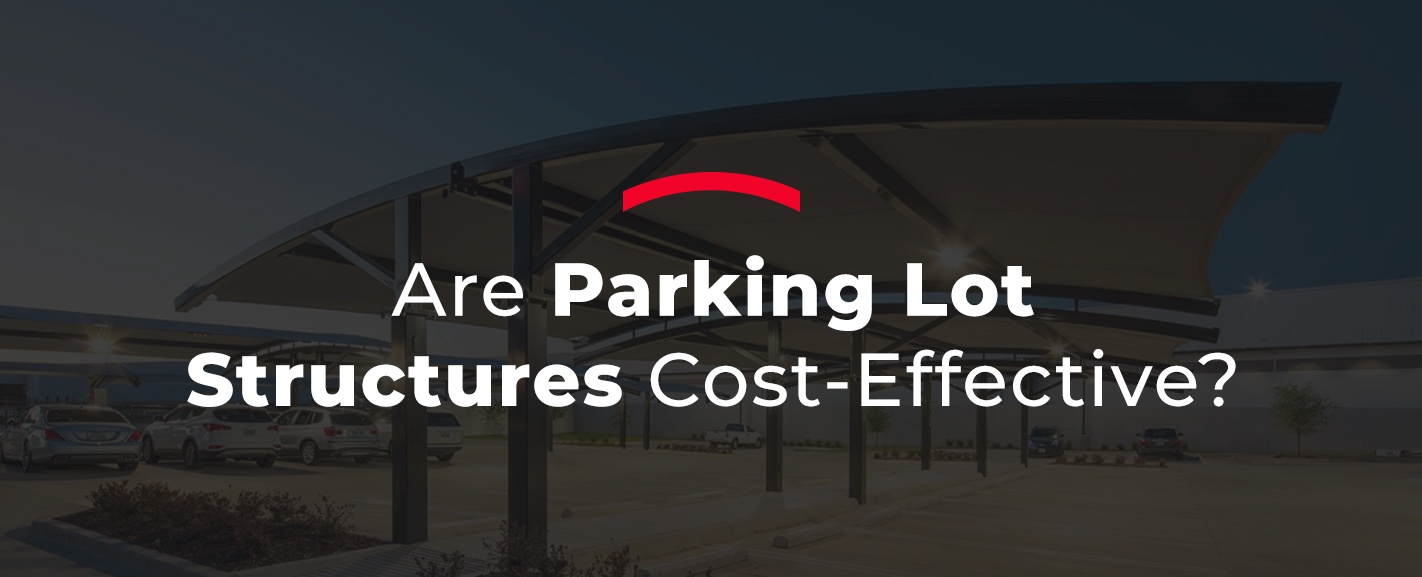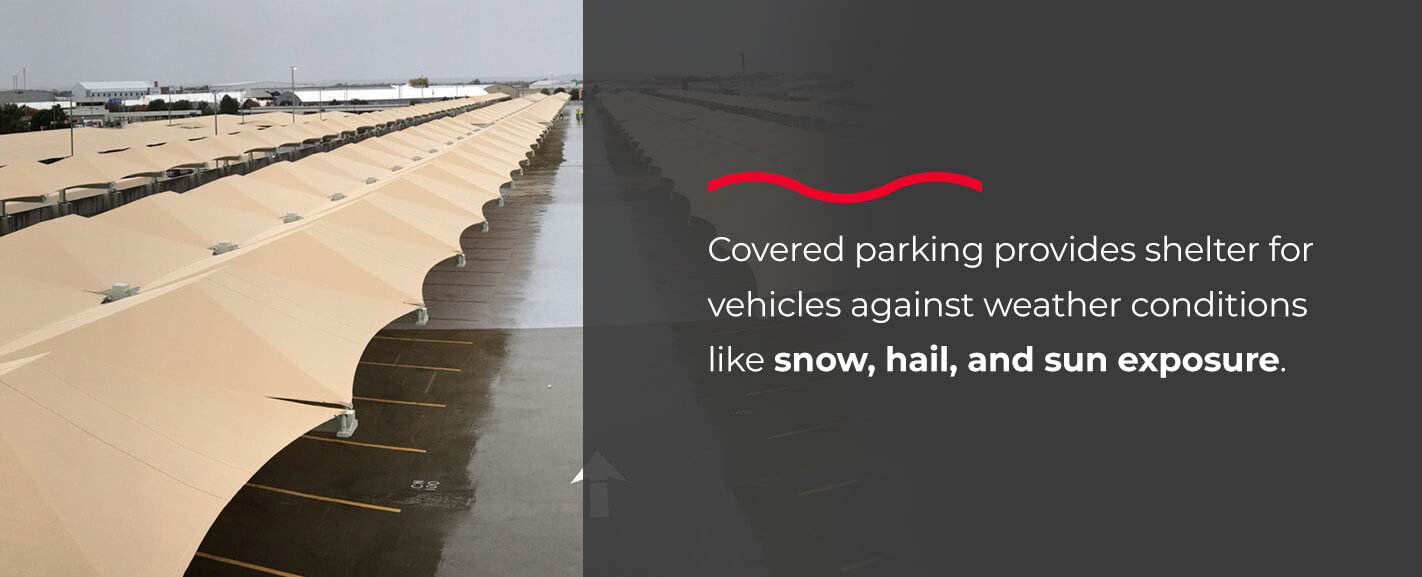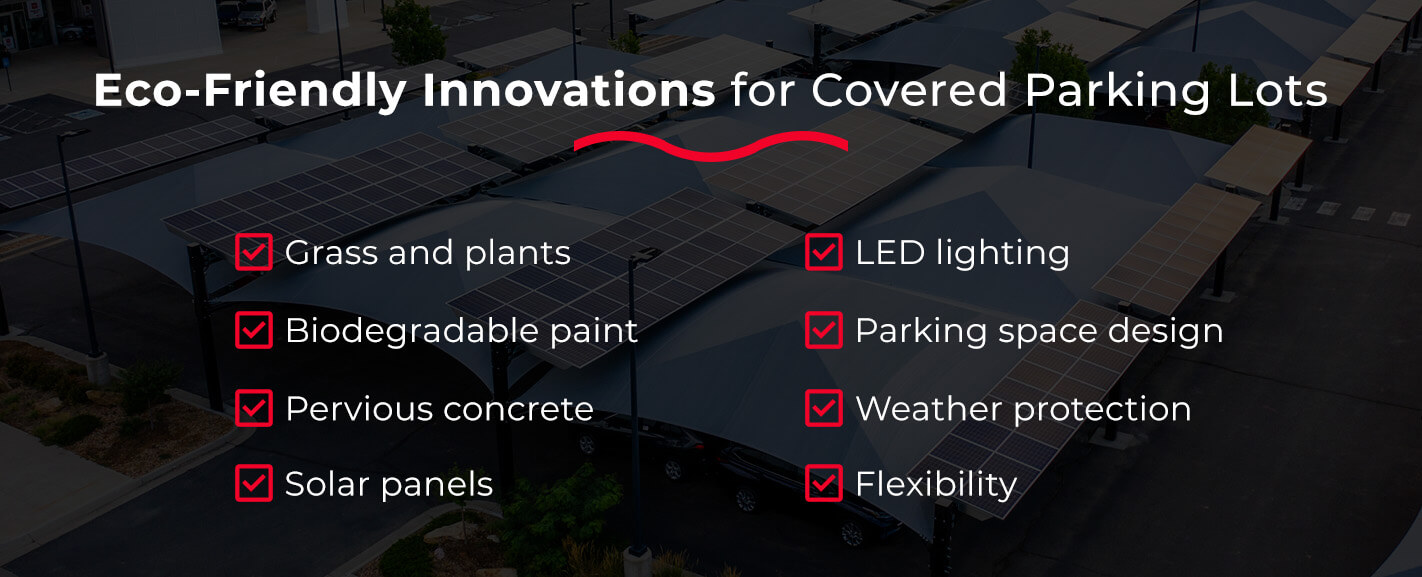Are Covered Parking Lot Structures Cost-Effective?
05.07.24

Today, covered parking structures serve a purpose beyond providing people with a place to park. Increasingly, parking lots are being designed with weather protection in mind, building value for the property and driving revenue for those businesses that charge for parking.
A top concern for commercial building owners is the financial aspect — whether covered parking lot structures are cost-effective. Building and maintaining covered parking lots involve significant upfront expenses. Thus, architects and building owners may wonder whether the benefits justify the initial costs.
These covered parking solutions can be quite cost-effective as a long-term investment for businesses. They can also provide weather protection for assets and inventory, and even qualify for tax incentives with the advent of sustainable features. In many ways, building a parking structure is a highly worthwhile investment for any business.
Whether you’re the owner of a car dealership, a commercial property, or a distribution center; or you manage an auto assembly plant or airport parking lot, consider how standard and solar-enabled covered parking structures can benefit your business and your customers.
Ready to add a parking lot structure to your business? Contact our team of experts today to learn about the variety of solutions we offer!
Read the full article or jump to a specific section:
- The Basics of Covered Parking
- How Much Do Covered Parking Structures Cost?
- Design Considerations for Maximum Efficiency
- Covered Parking Lot Designs for Specific Industries
- Benefits of Parking Lot Protection Structures
- Parking Structure ROI and Payback Period
- Protect Your Commercial Lot With VPS
The Basics of Covered Parking
Covered parking provides shelter for vehicles against weather conditions like snow, hail, and sun exposure. These parking lots can be standalone structures or integrated into buildings. Covered parking structures are also available in various designs, from simple canopies to long-span coverage, offering a range of options to suit different needs.

A durable, well-built, covered parking structure provides the following benefits:
- Hail protection
- UV protection
- Heat protection
- Branding and marketing opportunities
- Natural air ventilation
- Light fixture accommodation
- Energy savings potential with solar panel installation
How Much Does a Covered Parking Structure Cost?
To determine whether covered parking will provide a beneficial return on investment (ROI), it’s important to get an estimate that is specific to your business and property.
Generally, the cost to build a parking structure depends on:
- Structural design: The architectural complexity of the structure, including unique shapes, materials, and features, can significantly impact construction costs. Fabric shade-covered parking requires just 15%-25% of the expenses that would go into adding a concrete rooftop parking deck.
- Size and capacity: The size of the covered parking lot and the number of parking spaces required will affect the overall construction costs. Larger structures that need to cover more space will generally cost more to build.
- Materials: The choice of materials for the structure, such as steel, concrete, or tensile fabric, can influence costs. High-quality materials and specialized finishes can require more of an investment, but they often last longer and provide more benefits than cheap options.
- Terrain: Soil conditions, terrain, and the need for foundation work may impact construction costs. Terrains with poor soil quality often require additional groundwork to strengthen the foundation. In contrast, adding structures to an existing parking lot is more cost-effective than building one from the ground up.
- Location: The location of the parking area can influence the costs. Areas far away from amenities or with limited access to construction vehicles and materials require additional logistics and planning.
- Permits and regulations: Compliance with building codes, zoning regulations, and permits affect the construction costs of new parking areas. On an existing parking site, there may be no additional costs for permits and applications.
- Architectural design: Design, engineering, and project management services play a significant role in covered parking structure expenses.
- Additional features: Incorporating technology like solar panels or energy-efficient lighting can add to initial construction costs.
When it comes to finding cost-effective parking solutions, start with one that is tailored to a specific site and commercial application.
Design Considerations for Maximum Efficiency
Designing covered parking lots involves careful planning. It's important to optimize space usage, enhance user experience for drivers, and ensure operational effectiveness.
Eco-Friendly Innovations for Covered Parking Lots
An effective way to offset the costs associated with a covered parking project is to add sustainable designs and features. Sustainability practices can reduce costs over the long term and even increase business revenue.
Here are some design considerations for sustainable covered parking structures:
- Grass and plants: Parking lots with greenery reduce stormwater runoff and lower the heat island effect compared to sites without grass.
- Biodegradable paint: Regular paint contains volatile organic compounds that are harmful to the environment. Eco-friendly paint is made from renewable materials that affect the environment less.
- Pervious concrete: Unlike regular concrete, pervious concrete and permeable paving materials allow water to drain through it, leaving fewer puddles in parking lots.
- Solar panels: Installing commercial solar shade structures generates renewable energy and reduces emissions.
- LED lighting: Energy-efficient lighting options last longer, save replacement and maintenance costs, and lower a business's carbon footprint.
- Parking space design: A parking lot layout should optimize available space while minimizing traffic congestion. Depending on the facility, enough space should be allocated to structures to accommodate different types and sizes of vehicles.
- Weather protection: PVC-coated fabrics and PTFE-coated glass-cloth parking structures reduce hail damage to vehicles and provide protection from heat and UV exposure. These materials have long life spans and need little maintenance and cleaning.
- Flexibility: Flexible design elements allow businesses to expand or modify covered parking structures as needed. They also incorporate potential future changes in technology, such as electric vehicle charging stations or smart parking systems.

Covered Parking Lot Designs for Specific Industries
Investing in covered parking structures can be a wise decision for businesses across various markets.
- Car dealerships and auto assembly plants: Covered parking structures prevent product damage and loss from hail at manufacturing facilities, auto assembly plants, and car dealerships. These businesses hold massive inventory in their open lots, awaiting outbound distribution. While awaiting shipment, these new vehicles are staged out in the elements, exposed to damaging UV rays and the possibility of inclement weather. As such, the auto industry is one of the top investors in covered parking structures.
- Commercial and travel parking providers: Commercial and travel businesses, such as regional and international airports, cruise terminals, train stations, and grocery stores, also invest in covered parking structures to protect vehicles. For these markets, long-term covered parking terminals benefit the customer and can offer the potential for additional revenue by offering a premium covered parking option. Integrating solar into a covered parking project can be a smart decision, particularly for publicly funded projects.
- Distribution centers: Prolonged exposure to intense sunlight and heat may damage products and reduce workers' productivity. Shade structures for trucks and distribution vehicles can improve operating conditions and prolong product life span.
- Corporate parking: Covered parking is a premium amenity companies can provide to their executives and employees, giving them a more convenient, protected place to park their personal vehicles.
Benefits of Parking Lot Protection Structures
Overall, parking lots with covered structures provide numerous benefits for businesses. Here are some of the top reasons to install covered parking structures:
1. Protect Vehicle Assets

Auto dealerships and assembly plants are home to millions of vehicles at any given time across the country. As one of the nation’s most vital economic contributors, the auto assembly and distribution industry requires ongoing innovation to maintain and grow their profits. One of the most integral investments in the automotive industry has been covered parking.
In hail-prone regions, unpredictable weather can quickly cause millions of dollars in damage to new vehicles sitting on open lots. Sometimes, the damage can be so significant that brand-new vehicles become a write-off, which can have a serious financial impact on affected business owners. Significant hailstorms can also temporarily halt operations. Hail protection structures are structurally sound solutions that are custom-built to meet the needs of each property and business owner, keeping vehicle inventories safe from the elements.
2. Provide an Up-Sell Opportunity
In addition to the many benefits of covered parking structures, these products also allow businesses to up-sell their customers by offering a premium covered parking option. Covered parking can be a sustainable revenue stream for parking lot operators, eventually offsetting the initial investment and producing all profit following the ROI period.
3. Increase Commercial Property Value

Having the ability to park under a covered parking space at a commercial property is often an overlooked luxury — many people don't realize they prefer covered parking until they have to park in the open. Covered parking is a valuable amenity, particularly for commercial businesses looking for ways to set their property apart in the marketplace.
4. Optimize Commercial Lease Rates
Occupancy can fluctuate greatly in commercial properties, making this a primary challenge within the commercial real estate market. To improve tenant retention, property owners need to find ways to make their commercial spaces more appealing to potential tenants in order to solidify long-term lease agreements.

By investing in covered parking structures, businesses provide their tenants with the convenience of shaded parking for their vehicles. In harsh winter climates, covered parking structures can keep snow off of vehicles beneath, drivers the time and effort of removing that snow before leaving the property.
5. Maximize Rooftop Parking Use
Rooftop parking isn’t always a first-choice option, particularly during times of inclement weather. Many people avoid rooftop parking when temperatures are peaking or when storms are expected. Vehicle owners want to protect their cars from hail and the sun's UV rays. Additionally, on hot summer days, exposed parking can make vehicle interiors unbearably hot.

Property owners can maximize the usage of the top deck of their garage by integrating pre-engineered covered parking structures. Cantilevered structures are ideal for rooftop parking projects, as the structural columns are placed away from parking spaces and drive lanes. They’re a convenient and cost-effective solution compared to completely enclosing the top deck with steel and concrete.
Many manufacturing facilities and warehouses use their surface parking lots to store overflow inventory and parts. Though these open lots provide businesses flexibility in storing their goods, it can also pose a risk if their inventory isn’t properly protected.

Manufactured goods stored outdoors are at risk of several threats. Many manufactured products today are susceptible to damage when exposed to UV radiation. Because of industry regulations, these products may not be allowed to be coated or manufactured with UV stabilizers, so they require physical coverage instead. In other climates, hail, wind, and rain are the major threats to products stored outdoors.
By investing in protective structures, manufacturers can maintain the integrity of their inventory by reducing the risk of damage. UV and hail protection structures are uniquely designed to meet the needs of various industrial applications. These structures are built to suit the specific site to help increase the life cycle of manufactured goods.
7. Meet Local Regulations

More municipalities are legislating parking lot shade ordinances as a way to combat the urban heat island effect. Since heat gets trapped in densely populated spaces, metropolitan areas tend to have higher temperatures than rural regions. The urban heat island effect contributes to several environmental and health problems, including increased air pollution and energy consumption. Hot urban areas require additional energy to cool down, straining the power grid. Additionally, increased smog levels put children, seniors, and people with respiratory issues at risk.
Using a combination of trees, green space, and covered parking structures, municipalities can better address the urban heat island effect. Businesses operating in regions with parking lot shade requirements will benefit from the investment in covered parking structures by providing shaded parking and ensuring compliance with local legislation.
Parking Structure ROI and Payback Period

An initial investment in covered parking structures can serve businesses for years to come. While a shorter payback period is ideal, covered parking structures provide many opportunities for ROI.
- Businesses reduce damage expenses by protecting their inventories from the damaging effects of inclement weather.
- Commercial facilities have the opportunity to up-sell covered parking at a premium rate.
- Many airports nationwide have invested in covered parking structures and realized an accelerated ROI.
- Covered parking increases the property value of real estate, which attracts and retains commercial and retail tenants.
- Solar shade structures can save a business money on its utility bill, or even generate revenue by selling excess generated power back to the public grid.
- Project costs can be recouped by insurance premium reductions, utility savings, municipal and state renewable energy incentives, and state and federal tax credits.
- Fabric shade structures can withstand heat and moisture for many years, lowering short-term maintenance and replacement funds.
Overall, covered parking lots bring cost-efficiency, durability, and style to any building.
VPS Optimizes Covered Parking Investments
Are you considering investing in covered parking structures for your business? At VPS, we’re committed to driving innovative solutions in covered parking structures that protect business inventory, assets, and vehicles. We can even incorporate solar panels into covered parking structures, enabling businesses and municipalities to use renewable energy and optimize their covered parking investment.
Schedule a site assessment and evaluation, and we'll provide tailored solutions for any parking site. Our team of experts would be happy to help find the right structure for your project needs. Contact an expert at VPS today to learn more.
